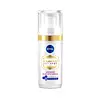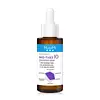What's inside
What's inside
 Key Ingredients
Key Ingredients

 Benefits
Benefits

 Concerns
Concerns

 Ingredients Side-by-side
Ingredients Side-by-side

Water
Skin ConditioningCaprylic/Capric Triglyceride
MaskingGlycerin
HumectantCocoglycerides
EmollientAlcohol Denat.
AntimicrobialDistarch Phosphate
AbsorbentGlyceryl Stearate
EmollientMethylpropanediol
SolventTapioca Starch
Cetearyl Alcohol
EmollientIsobutylamido Thiazolyl Resorcinol
BleachingSodium Hyaluronate
HumectantTocopheryl Acetate
AntioxidantSodium Stearoyl Glutamate
CleansingXanthan Gum
EmulsifyingCitric Acid
BufferingSodium Chloride
MaskingSodium Sulfate
Ethylhexylglycerin
Skin ConditioningPhenoxyethanol
PreservativeParfum
MaskingCI 15985
Cosmetic ColorantCI 47005
Cosmetic ColorantWater, Caprylic/Capric Triglyceride, Glycerin, Cocoglycerides, Alcohol Denat., Distarch Phosphate, Glyceryl Stearate, Methylpropanediol, Tapioca Starch, Cetearyl Alcohol, Isobutylamido Thiazolyl Resorcinol, Sodium Hyaluronate, Tocopheryl Acetate, Sodium Stearoyl Glutamate, Xanthan Gum, Citric Acid, Sodium Chloride, Sodium Sulfate, Ethylhexylglycerin, Phenoxyethanol, Parfum, CI 15985, CI 47005
Water
Skin ConditioningIsopentyldiol
HumectantPropanediol
SolventPentylene Glycol
Skin ConditioningTranexamic Acid
AstringentNiacinamide
SmoothingPhenoxyethanol
PreservativeXanthan Gum
EmulsifyingGlycerin
HumectantEthylhexyl Palmitate
EmollientGlycolic Acid
BufferingSodium Hydroxide
BufferingPolysorbate 80
EmulsifyingPhospholipids
Skin ConditioningDipropylene Glycol
HumectantBiosaccharide Gum-1
HumectantLactic Acid
BufferingSodium Magnesium Silicate
Citric Acid
BufferingDipotassium Glycyrrhizate
HumectantEthylhexylglycerin
Skin Conditioning1-Methylhydantoin-2-Imide
Skin ConditioningTocopheryl Acetate
AntioxidantCholesterol
EmollientHydroxypropyl Guar
Emulsion StabilisingHydroxybutyl Methylcellulose
Emulsion StabilisingDisodium EDTA
Hyaluronic Acid/Polyisopropylacrylamide Copolymer
HumectantGeranium Robertianum Extract
AstringentScutellaria Baicalensis Root Extract
AstringentHouttuynia Cordata Extract
Skin ConditioningCitrus Reticulata Peel Extract
Skin ConditioningAlgae Extract
EmollientCentaurea Cyanus Flower Extract
AstringentAspalathus Linearis Extract
Skin ConditioningPhaseolus Radiatus Sprout Extract
HumectantWater, Isopentyldiol, Propanediol, Pentylene Glycol, Tranexamic Acid, Niacinamide, Phenoxyethanol, Xanthan Gum, Glycerin, Ethylhexyl Palmitate, Glycolic Acid, Sodium Hydroxide, Polysorbate 80, Phospholipids, Dipropylene Glycol, Biosaccharide Gum-1, Lactic Acid, Sodium Magnesium Silicate, Citric Acid, Dipotassium Glycyrrhizate, Ethylhexylglycerin, 1-Methylhydantoin-2-Imide, Tocopheryl Acetate, Cholesterol, Hydroxypropyl Guar, Hydroxybutyl Methylcellulose, Disodium EDTA, Hyaluronic Acid/Polyisopropylacrylamide Copolymer, Geranium Robertianum Extract, Scutellaria Baicalensis Root Extract, Houttuynia Cordata Extract, Citrus Reticulata Peel Extract, Algae Extract, Centaurea Cyanus Flower Extract, Aspalathus Linearis Extract, Phaseolus Radiatus Sprout Extract
Ingredients Explained
These ingredients are found in both products.
Ingredients higher up in an ingredient list are typically present in a larger amount.
Citric Acid is an alpha hydroxy acid (AHA) naturally found in citrus fruits like oranges, lemons, and limes.
Like other AHAs, citric acid can exfoliate skin by breaking down the bonds that hold dead skin cells together. This helps reveal smoother and brighter skin underneath.
However, this exfoliating effect only happens at high concentrations (20%) which can be hard to find in cosmetic products.
Due to this, citric acid is usually included in small amounts as a pH adjuster. This helps keep products slightly more acidic and compatible with skin's natural pH.
In skincare formulas, citric acid can:
While it can provide some skin benefits, research shows lactic acid and glycolic acid are generally more effective and less irritating exfoliants.
Most citric acid used in skincare today is made by fermenting sugars (usually from molasses). This synthetic version is identical to the natural citrus form but easier to stabilize and use in formulations.
Read more about some other popular AHA's here:
Learn more about Citric AcidEthylhexylglycerin (we can't pronounce this either) is commonly used as a preservative and skin softener. It is derived from glyceryl.
You might see Ethylhexylglycerin often paired with other preservatives such as phenoxyethanol. Ethylhexylglycerin has been found to increase the effectiveness of these other preservatives.
Glycerin is already naturally found in your skin. It helps moisturize and protect your skin.
A study from 2016 found glycerin to be more effective as a humectant than AHAs and hyaluronic acid.
As a humectant, it helps the skin stay hydrated by pulling moisture to your skin. The low molecular weight of glycerin allows it to pull moisture into the deeper layers of your skin.
Hydrated skin improves your skin barrier; Your skin barrier helps protect against irritants and bacteria.
Glycerin has also been found to have antimicrobial and antiviral properties. Due to these properties, glycerin is often used in wound and burn treatments.
In cosmetics, glycerin is usually derived from plants such as soybean or palm. However, it can also be sourced from animals, such as tallow or animal fat.
This ingredient is organic, colorless, odorless, and non-toxic.
Glycerin is the name for this ingredient in American English. British English uses Glycerol/Glycerine.
Learn more about GlycerinPhenoxyethanol is a preservative that has germicide, antimicrobial, and aromatic properties. Studies show that phenoxyethanol can prevent microbial growth. By itself, it has a scent that is similar to that of a rose.
It's often used in formulations along with Caprylyl Glycol to preserve the shelf life of products.
Tocopheryl Acetate is AKA Vitamin E. It is an antioxidant and protects your skin from free radicals. Free radicals damage the skin by breaking down collagen.
One study found using Tocopheryl Acetate with Vitamin C decreased the number of sunburned cells.
Tocopheryl Acetate is commonly found in both skincare and dietary supplements.
Learn more about Tocopheryl AcetateWater. It's the most common cosmetic ingredient of all. You'll usually see it at the top of ingredient lists, meaning that it makes up the largest part of the product.
So why is it so popular? Water most often acts as a solvent - this means that it helps dissolve other ingredients into the formulation.
You'll also recognize water as that liquid we all need to stay alive. If you see this, drink a glass of water. Stay hydrated!
Learn more about WaterXanthan gum is used as a stabilizer and thickener within cosmetic products. It helps give products a sticky, thick feeling - preventing them from being too runny.
On the technical side of things, xanthan gum is a polysaccharide - a combination consisting of multiple sugar molecules bonded together.
Xanthan gum is a pretty common and great ingredient. It is a natural, non-toxic, non-irritating ingredient that is also commonly used in food products.
Learn more about Xanthan Gum